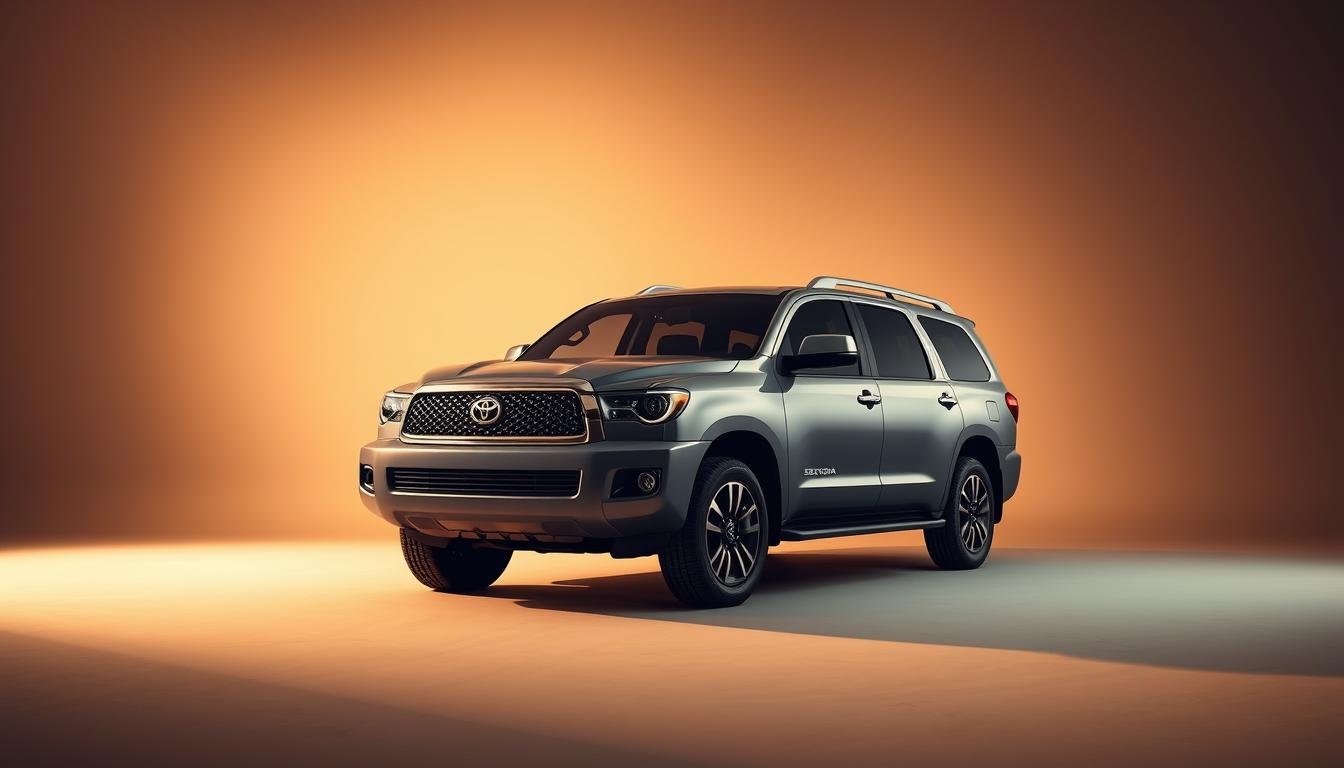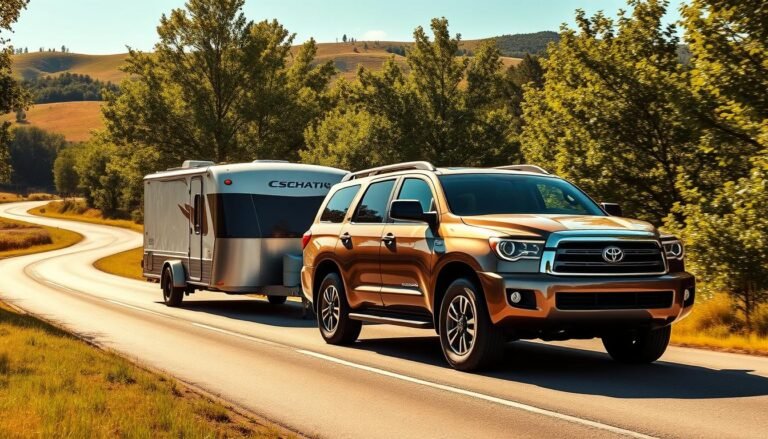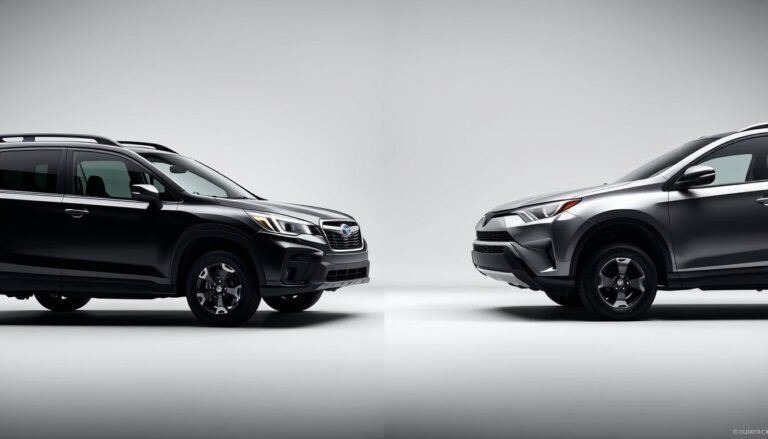What Is These Toyota Sequoia Years To Avoid? Essential 9 Buyer’s Guide
Models from 2001 to 2008 are the Toyota Sequoia years to avoid. The Sequoia is known for being reliable. But these early models often have problems.
These issues can lead to high repair costs and a bad experience with the SUV. Knowing which years to avoid is key when looking for a used Sequoia.
In this guide, we’ll look at the common problems of early Sequoias. We’ll highlight the main issues that new owners face.
Knowing the problems of each year can help you choose better. We will talk about repair costs, what other owners say, and how dependable these SUVs are.
Knowing which Sequoia years to avoid is important. This knowledge can prevent future problems. It also helps you find the best SUV for what you need.
Introduction To The Toyota Sequoia
The Toyota Sequoia is a robust, full-size SUV loved for its big interior and strong performance.
It was crafted to serve both families and adventure seekers. It bridges the gap between the smaller Toyota 4Runner and the luxurious Toyota Land Cruiser.
For more than twenty years, the Sequoia has been improving. It offers a roomy cabin, advanced safety features, and plenty of cargo space.
This makes it a great choice for different types of people. However, it has faced some challenges, especially in reliability and safety.
Despite this, the Sequoia remains a top pick for those who want both functionality and trustworthiness in an SUV.
Overview of Toyota Sequoia Generations
Since 2001, the Toyota Sequoia has seen a lot of changes. The first generation, running until 2007, had its share of issues.
These early problems made Toyota rethink and improve their designs and engineering for later models.
The second generation started in 2008 and was a big leap forward for the Sequoia. It came with major improvements to fix past complaints.
However, it wasn’t perfect and had its own set of challenges, especially with the transmission and engine, which impacted customer happiness.
| Generation | Production Years | Key Features | Common Issues |
|---|---|---|---|
| First | 2001-2007 | Basic features, strong towing capacity | Quality control problems, reliability issues |
| Second | 2008-Present | Modernized design, improved safety features | Transmission problems, engine performance issues |
Common Toyota Sequoia Problems
The Toyota Sequoia is tough and capable but faces challenges. Owners have found toyota sequoia common problems across different years.
Issues often start showing around 100,000 miles, especially with the transmission in older models. Brake wear is also a common issue leading to higher maintenance costs.
Electrical problems can cause erratic dashboard readings and other component failures. Rust, especially on the frame, is a problem in places with bad weather.
It’s key to check a used Toyota Sequoia for these issues before buying. This helps avoid extra costs later.
Toyota Sequoia Years To Avoid
If you’re looking at buying a Toyota Sequoia, some years might not be a good choice. This is due to some reliability issues.
The models from 2001 to 2008 are known to have more problems. It’s good to know about these problems before you decide to buy.
Models from 2001 to 2008
The Toyota Sequoia models made between 2001 and 2008 have quite a few issues. Avoiding these years can save you from a lot of trouble and expensive repairs later.
Specific Issues by Year
| Year | Common Issues |
|---|---|
| 2001 | High brake wear rates |
| 2002 | Engine failures and problematic VSC systems |
| 2003-2004 | Continued brake issues and complaints about rusting frames |
| 2005-2008 | General electrical problems and transmission failures. Particularly in 2008, issues with power steering and camshaft tower leaks |
In general, the Sequoia models to avoid show much worse reliability than those made after 2008.
Knowing about these specific years helps you make a smarter decision when buying a used car.

Toyota Sequoia Reliability Issues
The Toyota Sequoia’s reliability has been much talked about. Owners and automotive experts have weighed in.
They’ve used reliability scores and consumer opinions to get a clear view of what the Sequoia is like.
Reported Reliability Scores
Sequoias made from 2001 to 2004 often got low reliability scores. This was because they broke down a lot and fixing them cost quite a bit.
But starting in 2008, things got better. This was thanks to better ways of making them and stricter quality checks.
Even with these improvements, some Sequoias made between 2010 and 2013 had issues. These problems mostly had to do with parts wearing out as the vehicle aged.
Consumer Feedback
How happy people are with their Sequoias varies by the year it was made. Early versions were criticized for not being reliable enough and needing too much upkeep.
People were upset that many important parts didn’t last long. On the other hand, newer models seem to be more reliable.
But, troubles have popped up in Sequoias from 2010 to 2013 again. People are worried if these cars can stand the test of time.
Toyota Sequoia Notorious Years
The Toyota Sequoia has seen several years with a lot of complaints. If you’re thinking about buying a used one, it’s smart to know about these toyota sequoia notorious years.
Learning about complaints can reveal possible issues with certain years.
High Complaint Counts
The year 2002 stands out for the Toyota Sequoia due to engine and braking issues. It’s known as a rough time for this model.
The 2008 Sequoia also had problems, mainly with its transmission. These issues led to unhappy owners and costly repairs.
Specific Problematic Features
Looking at the models, some features got a lot of complaints. The Vehicle Stability Control (VSC) system, especially in newer years, had many failures.
This raised safety concerns. Also, air injection pumps were another big problem, causing more headaches and high repair bills for owners.
| Model Year | Complaint Type | Key Issues |
|---|---|---|
| 2002 | Engine and Braking | High failure rates, costly repairs |
| 2008 | Transmission | Reliability issues, user dissatisfaction |
| 2010 | VSC System | High failure rates affecting safety |
| 2015 | Air Injection Pump | Frequent failures leading to performance issues |

Maintenance Pitfalls in Earlier Models
If you’re eyeing older Toyota Sequoia models, made from 2001 to 2008, be cautious. There are several toyota sequoia maintenance pitfalls to consider.
These older vehicles often need more care. This is due to design issues that may cause early failures in key parts.
Pay close attention to several critical areas, such as:
- Suspension System: Early versions may suffer from wear, leading to a bumpy ride and expensive fixes.
- Brake Systems: You might find the brakes acting up, requiring regular attention for your safety.
- Rusting Frames: In cold climates, watch out for rusting frames that jeopardize the car’s structure.
- Transmission Issues: Be on the lookout for specific transmission problems needing quick care.
Regularly checking these parts can save you from the toyota sequoia maintenance pitfalls. This is crucial to keep your Sequoia running safely and smoothly for longer.
Comparison with Competitors
Comparing the Toyota Sequoia to rivals like the Chevrolet Tahoe and Ford Expedition reveals some key differences.
The Sequoia stands out for its power and roominess, which is great for families or those needing a lot of space.
However, the Tahoe and Expedition also have strong points, but the Sequoia tops them in performance.
The downside is that Sequoia’s rivals are ahead in tech and fuel economy. Its gas mileage doesn’t stack up well against others in its category.
This might make some buyers think twice, especially if they want an efficient vehicle. Also, despite a comfy interior, the Sequoia’s design feels old compared to the Tahoe and Expedition’s newer looks and tech.
Making a smart choice between these SUVs means knowing what’s most important to you. Maybe you value power and space more, or maybe tech and efficiency are your top concerns
Knowing the Sequoia’s pros and cons compared to its competitors helps you choose the right SUV for you.
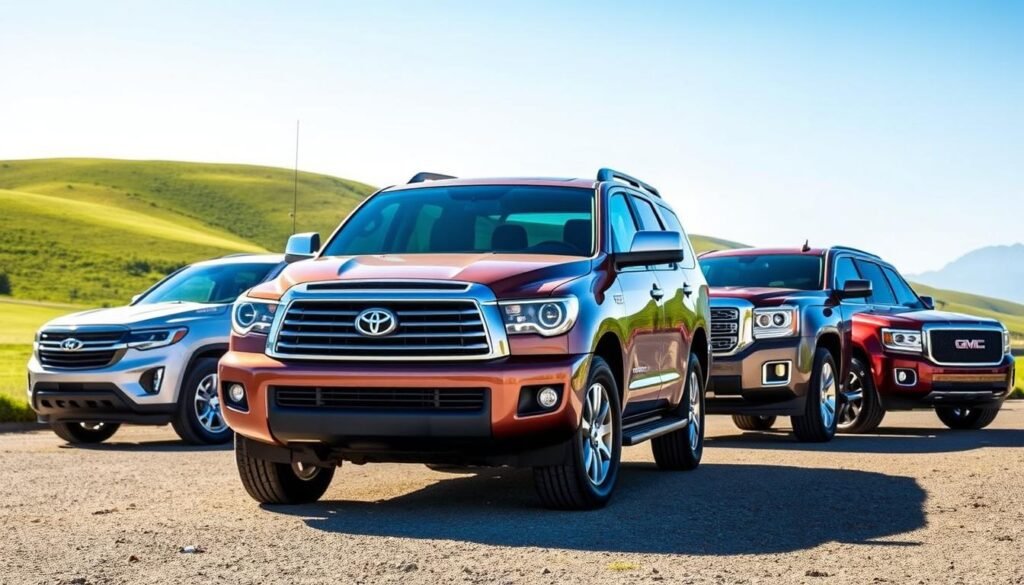
Safe Toyota Sequoia Years To Consider
Looking for a Toyota Sequoia? Choose certain years to get a better, safer car. Models made later have fewer problems and better safety. They give you a good feeling when driving.
Model years with fewer reported issues
From 2009 to 2019, the Sequoia models are top picks. They got big updates that fixed old issues. People who have these cars say they run better and need less fixing up.
Improvements in later models
The 2018 Sequoia is special because it got new safety stuff. It has things like automatic speed control and warnings if you drift off the road.
If safety and not having problems are important to you, look at these newer models.
Important Safety Features To Look For
Looking into a Toyota Sequoia means you care about safety. Recent models come with top-notch protection technology. This tech works to stop accidents and keep everyone safe if one happens.
The Toyota Safety Sense system is a key feature. It has:
- Pre-Collision Warning: Alerts you to dangers so you can avoid crashes.
- Lane Departure Alerts: Warns you if you’re leaving your lane by mistake.
- Adaptive Cruise Control: Adjusts your speed to keep a safe distance from cars ahead.
Older models of the Sequoia might not have these new tools but still offer basic safety. You get airbags, anti-lock brakes, and stability control.
While helpful, they aren’t as advanced as the newest features. Knowing about these features helps you pick the right car. The table below compares safety tech across different years:
| Model Year | Safety Technology Available |
|---|---|
| 2023 | Toyota Safety Sense, Pre-Collision System, Lane Departure Alert, Adaptive Cruise Control |
| 2015 | Basic Airbags, Stability Control, Rearview Camera |
| 2010 | Basic Airbags, Stability Control |
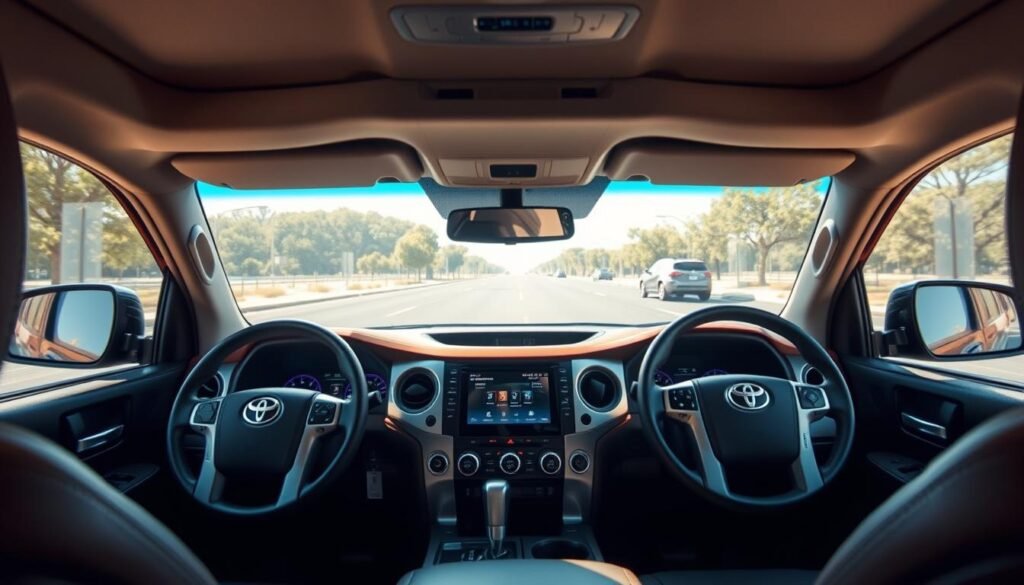
Knowing how safety features have improved helps you choose wisely. Safety should be a priority in your search. Go for a Sequoia that best protects your family.
Tips For Buying A Used Toyota Sequoia
When buying a used Toyota Sequoia, some tips can make the process better. Begin by getting a detailed vehicle history report.
It shows vital info like past accidents or big repairs, helping you choose wisely. Check the vehicle for issues that often come with age.
Look closely at the rust on the frame, which affects both safety and longevity. Also, make sure it runs well to avoid costly repairs later.
Getting a pre-purchase inspection by a trusted mechanic is smart. Though frequently skipped, it offers deep insights on the vehicle’s condition.
This can help ensure your Sequoia is reliable for many years, avoiding unexpected maintenance costs.
Conclusion
The Toyota Sequoia can be a great choice for families who need space and trustworthiness. But, it’s crucial to avoid certain years to dodge unexpected repairs.
Specifically, models from 2001 to 2008 have known reliability problems, affecting your enjoyment of the car. When buying, aim for newer models.
They’re more reliable and have better features. Doing your homework and checking reviews can help you pick a good Sequoia.
This way, you enjoy the Sequoia’s roominess and power without worrying about reliability.
Choosing carefully means the Sequoia can offer a smooth and lasting ride for your family. Make smart decisions, and this strong SUV will serve you well.
FAQs
What are the Toyota Sequoia years to avoid?
Avoid Toyota Sequoia models from 2001 to 2008. They have many reliability issues and high maintenance costs.
What common problems does the Toyota Sequoia face?
Common issues include excessive brake wear, transmission failures, electrical glitches, and rusting frames in older models.
Are there specific Toyota Sequoia model years that have notorious reliability issues?
Yes, models from 2001, 2002, and 2008 are known for major reliability issues. These include engine and transmission problems.
How reliable is the 2007 Toyota Sequoia compared to newer models?
The 2007 model is less reliable because it shares issues common to earlier years. Models from 2009 onwards are much better in durability and have fewer problems.
What maintenance pitfalls should I be aware of for earlier Toyota Sequoia models?
Pay close attention to the suspension and brake systems. Without regular care, these parts often fail in models from 2001 to 2008.
How do Toyota Sequoia models compare with competitors like Chevrolet Tahoe?
The Sequoia has more power and space. But, it falls short in modern tech and fuel efficiency when compared to the Chevrolet Tahoe and Ford Expedition.
What safety features should I look for in a Toyota Sequoia?
Look for recent models with Toyota Safety Sense. It includes pre-collision warnings, lane departure alerts, and adaptive cruise control.
What tips should I follow when buying a used Toyota Sequoia?
Do your homework. Check the car’s history reports, watch for common issues like rust, and get a trusted mechanic to inspect it before buying.
Which Toyota Sequoia model years are considered safe and reliable?
Choose models from 2009 to 2019 for their enhanced reliability and performance. Safety got a big boost in 2018 models.

